 |  |
 |  |
|
The size of a cigar, in name, is a nearly meaningless
designation, the reason being that the size of a cigar, when determined by
a name such as corona or robusto, is not a universal standard. In other words,
one company's corona is another company's churchill even though both measure
the exact same length and ring gauge. Once you understand this, most of the
confusion regarding cigar size disappears. There are, however, "classic" measurements for cigars that most cigar makers attempt to follow, and these are shown in the pictures below. But remember, just because a cigar is 7 inches in length with a 48 ring gauge doesn't necessarily mean that the manufacturer will designate that cigar as a churchill. All you really have to know is that cigars are categorized by length and ring gauge which is a measurement divided into 64ths of an inch, or more simply put, is a fraction of 64. A cigar with a 52 ring gauge, for example, measures 52/64ths of an inch in diameter. |
Classic Measurements
Straight-Sided Cigars
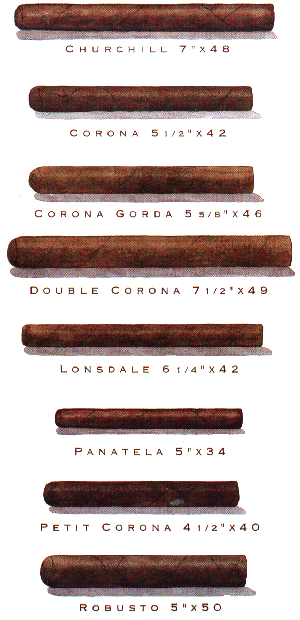
Shaped Cigars
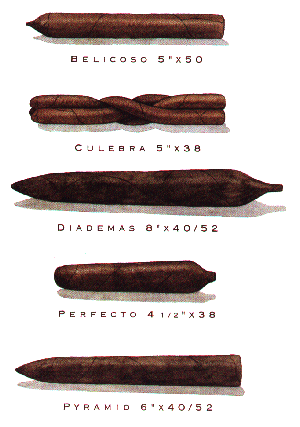
|
Handmade premium cigars must obviously be cut before they are smoked,
and there are several methods available to accomplish this task. A double-blade guillotine cutter is probably the best way to cut a cigar. All you need do is place the head of the cigar between the blades and squeeze each side of the cutter. Because there are two blades, the double-blade cutter will apply equal pressure to both sides of the cigar. A single-blade guillotine cutter accomplishes the same result but uses only one blade. However, because there is only one blade the pressure is not equal on both sides of the cigar which could cause damage to the wrapper. Guillotine cutters are not the only tools for cutting cigars. Scissors are also made for cutting the head. However, I don't especially recommend them. They have to be very sharp to get the job done. They also aren't as stable and as easy to use as a guillotine cutter. Lastly, a scissors cutter isn't quite as easy to carry around as a guillotine cutter. Another type of cutter is a V-cutter which leaves a v-shaped gouge in the cigar. I've never tried this type of cut, but from what I've read the v-cut is not as strong as a regular circular cut. In other words, the head of the cigar may collapse, or at least become soft and mushy, which would then lead to the build-up of tar and effect the taste of the cigar. The only other tool I know of to open the wrapper at the head of a cigar is not a cutter but a drill. These gadgets go by several names, but what they do is essentially punch a hole in the wrapper which allows the smoke to pass through the head. I don't recommend this type of pierce cut either because the smoke is concentrated at one point which also may cause a build-up of tar. Both a guillotine and scissors cutter are pictured below. |
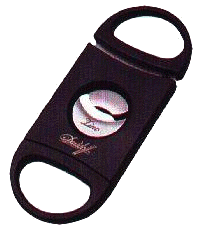 |
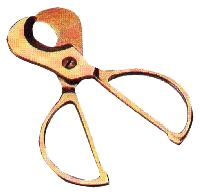 |
|
Lighting a cigar may seem like a no-brainer, but there are a few
"guidelines" of which you should be aware. To begin with, it's a good idea to use either matches or a butane lighter for the job. Why? Well, just about anything else that you could use to light a cigar will effect the cigar's taste. Regular fluid lighters have an odor that can be transferred to the cigar if the flame is allowed to touch the foot. In same way, flame from a candle, or anything else that either produces particles or has an odor can ruin the flavors of the tobacco. Whatever you choose, try not to let the flame touch the foot as you rotate the cigar in your fingers. Some people feel that after embers appear on the end of the foot you should blow through the cigar to make sure that odors which may have come from the flame do not effect the cigar's taste. If you're using matches, you may have to use 2 or 3 in order light the cigar properly. |
 |
|
The taste and flavor of a cigar is not exactly an objective measurement
derived from a careful analysis of the cigar. Instead, taste and flavor vary
from person to person and, in fact, may even be different from one La Unica
#100 to another La Unica #100. Just because I found a cigar to have a wood flavor doesn't necessarily have to mean that you should as well. The flavor of some cigars can be a bit difficult to describe while others have a taste that everyone will recognize. According to some, there are only four basic tastes that the mouth is able to discern: sweet, sour, salty and bitter, and that every other taste is merely a combination of these four. Some cigar makers agree and prefer not to use food words to describe a cigar's flavor, using instead these four basic tastes and others such as acidic, smooth, heavy, rich, etc. Still, many others prefer food language to describe taste and use words such as chocolate, coffee, nutty, etc. My personal opinion is that you should use whatever words you need to use to describe a cigar's flavor, and don't listen to anyone who says that "food language" is only used by cigar snobs. The truth is, the sense of taste is very closely related to the sense of smell and, in fact, are difficult to separate from each other. What many people don't realize is that taste is altered by both the presence and absence of smell, so much so that the scent of food (and cigars) contributes to and is a part of its taste. In other words, you don't have to have eaten grass in order to experience a grassy flavor in a cigar. So, to sum up, if a cigar has a metallic character or tastes like a burning tire then that's how you should describe it. On a more serious note, you should know that there are a few factors about a cigar's construction that contribute to its taste and flavor. To begin with, the wrapper should appear somewhat oily, and by that I don't mean drenched in oil. A good indication of oil is how much of a shine the wrapper shows. At any rate, oil indicates that a cigar has been properly humidified because oil secretes from tobacco at 70 to 72 percent humidity. Another evaluation you can make is with the cigar's ash and burn rate. Most cigar experts tend to think rich soil produces a whiter ash, indicating better taste. As for the burn rate, I can assure you that an uneven burn is a thing to avoid. When a cigar burns unevenly, the wrapper's taste is not being fully realized. This could result in the wrapper totally extinguishing and cause the tobacco to burn hot in the center of the cigar (this is called tunneling which contributes to a distortion in flavor) which leads to a generally unpleasant experience. What gives a cigar its variety of tastes is simple; a blending of several different tobaccos in one cigar. There are a couple of reasons why this is done. The first is to compensate for the altered taste of the tobacco leaf which varies from year to year. The second reason is the most obvious, to make the cigar more interesting. As you can probably imagine, achieving the same balance of tobacco year after year is not an easy task, especially when you consider how many variables can alter the taste of a tobacco blend. The last factor to consider is the construction of the cigar. Basically, an under filled or overstuffed cigar is bad news. When under filled, the tobacco burns hotter than it should which lets too much smoke pass through the cigar too quickly. This leads to a harsh, perhaps bitter taste which will eventually lead you to discard the cigar altogether. When overstuffed with tobacco, the draw will be somewhat difficult, sometimes impossible, but will always tend to mean less flavor (due to less smoke passing through) and, once again, tossing the cigar into the trash. To sum up, the flavor and taste of a cigar come from the quality of the wrapper, ash color, burn rate, and the overall complexity of what you taste from the smoke itself. How you describe the flavors, though, is entirely up to you. |
| It is well known that cigars are a naturally hydroscopic product that require proper humidification if they are to be kept fresh. The best tobacco leaves are grown and then hand rolled in areas such as Cuba, Cameroon, Dominican Republic and the Philippines. In these equatorial and tropical regions the humidity is approximately 70 percent, the prescribed humidity for your humidor. Most humidistats have specially designed active ingredients that will self regulate to maintain the proper humidity needed for cigar storage. You can usually buy or make your own humidor and put in a humidistat that will regulate the humidity. Also in your humidor you should have a piece of Spanish Cedar wood to keep the cigars smelling fresh. |
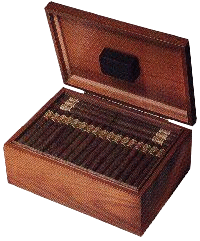 |
| Band | A ring of paper around the head of the cigar denoting the cigar's brand. |
| Binder | A tobacco leaf used to hold the filler leaves together. |
| Blend | The mixture of different types of tobacco in a cigar. |
| Bloom | A fine white powder appearing on a cigar caused by oil that exude from the tobacco. |
| Bulk | A pile of tobacco leaves in the process of fermentation. |
| Bunch | The body of a cigar created by the different types of tobacco that are blended together. |
| Bundle | A way of packaging cigars using cellophane wrapping. It usually contains 25 or 50 cigars. |
| Candela | A bright green shade of wrapper. Also called double claro. |
| Cap | The circular piece of wrapper at the head of a cigar. |
| Claro | A pale green to light brown wrapper which is usually shade grown. |
| Colorado | A medium brown to brownish red wrapper. |
| Draw | The amount of air pulled through a cigar. |
| Fermentation | The first stage of preparing the tobacco after it is harvested. The process releases ammonia. |
| Figurado | A cigar with an exotic shape. |
| Filler | The tobacco leaves used to make up the bunch. |
| Flag | An alternative to the cap. It involves twisting the wrapper at the head into a pigtail. |
| Foot | The end of the cigar that you light. |
| Gum | A vegatable adhesive used to secure the head of the wrapper. |
| Hand-rolled | A cigar made completely by hand with long filler tobacco. |
| Head | The end of the cigar that you cut and smoke. |
| Hot | This describes a cigar that is underfilled and has a loose, easy draw. |
| Humidor | An environment (room or box) designed to preserve and age cigars. |
| Long filler | This describes filler tobacco that runs the length of the cigar. |
| Machine-made | A cigar made by machine using a heavy wrapper and cut filler instead of long filler. |
| Maduro | A very dark reddish brown to almost black wrapper. |
| Oscuro | A black shade of wrapper. |
| Puro | A term used to distinguish a cigar from a cigarette. |
| Ring gauge | A measurement of the diameter of a cigar, in inches, based on a fraction of 64. |
| Shade-grown | Wrapper leaves grown under a tent which creates a thinnner and more elastic leaf. |
| Sun-grown | Tobacco grown in direct sunlight which creates a thicker leaf. |
| Wrapper | The tobacco leaf which is wrapped around the bunch and binder. |
| Back |
|